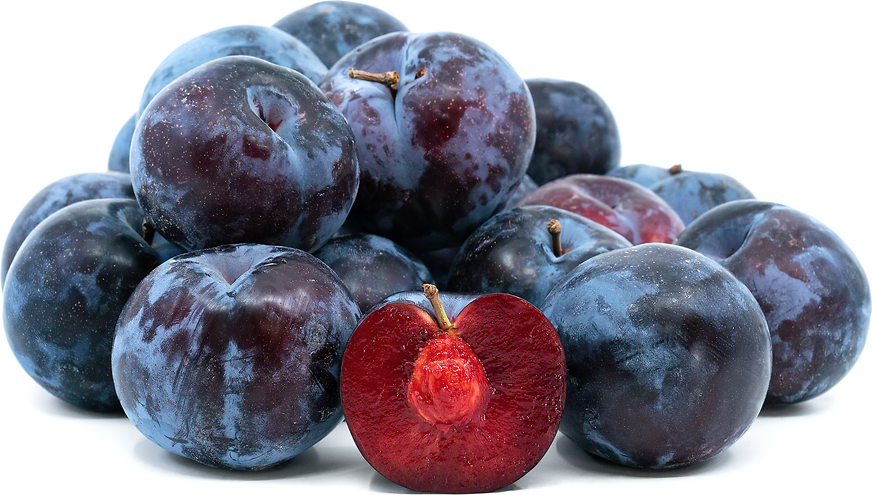


Black Splendor Plums
Estimated Inventory, cs : 0
Description/Taste
Black Splendors are a hybrid breed of plum. They are a larger-than-average variety, measuring 5 to 6 centimeters wide. Their skin has a dark purple hue with a waxy texture and a faint, white residue covering the surface. The fruit features small white dots speckled across the skins surface. Beneath the skin is a juicy, beet-red flesh that's firm and juicy when bitten in to. In the midst of this flesh is a light brown pit, or stone, that's hard, inedible, and of the clingstone variety, meaning that the stone does not cleanly separate away from the flesh. Black Splendor plums are tart and slightly bitter but balanced by rich, sweet flavors.
Seasons/Availability
The Black Splendor plums are an early-season plum that’s available from late spring to summer.
Current Facts
Black Splendor plums, botanically known as Prunus salicina, belong to the Rosaceae family, which also includes peaches, cherries, almonds, and apricots. This beet-colored variety is valued for its culinary uses, particularly as a fresh eating plum. Compared to the Santa Rosa plum, an industry-standard variety from the Central Valley, Black Splendor plums are larger, tarter, and ripen earlier. They are one of the 2,000 plum varieties found worldwide, with 400 varieties present in the United States. The term "American Plum" generally refers to a wide variety of plums native to North America before the arrival of European colonists. While many of these native varieties remain today, most plums found in supermarkets are domestic hybrids specifically cultivated for North American growing conditions.
Nutritional Value
All black plum varieties, including Black Splendor plums, contain vitamins C, K, and A. These vitamins are important for immune and skin health, preventing cell damage, iron absorption, blood clotting, maintaining bone density, and promoting good vision. This fruit is a source of fiber, which helps with digestion, weight management, and controlling blood sugar and cholesterol levels. Black plums provide the body with magnesium, calcium, and potassium, nutrients that help support the nervous system, muscle function, blood pressure regulation, and teeth health.
Applications
Black Splendor plums are often consumed fresh, though they can be cooked, stewed, pickled, or preserved in jams and compotes. They may be sliced fresh to serve on top of salads, granola, yogurt parfaits, oatmeal, waffles, and pancakes. This variety is often cooked into cobbers, cakes, crumbles, tarts, and muffins. The Black Splendor may be pureed into puddings, sorbets, and plum sauces or fermented into wine or brandy. Plum sauces can enhance both sweet recipes, like baked goods, and savory dishes when poured over lamb or crispy pork. This sauce is also popular in Chinese dishes like Peking duck and egg rolls. Black Splendor plums pair well with ingredients like salad greens, lemon, ricotta, blackberries, blueberries, raspberries, apricots, apples, pears, pecans, and roasted meats.
Ethnic/Cultural Info
In the United States, most plum varieties are hybrids of either Japanese plums, Prunus salicina, or European plums, Prunus domestica. The botanical name of Black Splendor plums indicates their descent from Japanese plums. Although European plums were introduced to the United States earlier, Japanese plums have achieved greater commercial success. This is because they bloom earlier, require fewer chilling hours, and are larger. Japanese hybrids are typically consumed fresh, while European varieties are more commonly used for dried plums. Many Japanese-hybrid varieties, including Black Splendor plums, are grown in California, which produces 90% of the United States' commercial plum crops.
Geography/History
Black Splendor plums are native to the Central Valley of California and are descendants of Japanese plums. This variety grows best in climates with warm summers and mild winters. As a hybrid breed, they are not found in the wild but are cultivated for commercial production and in home gardens. Black Splendor plums emerged from the surge of Japanese-American hybrid plums developed in the 1870s when Luther Burbank successfully planted a plot of Japanese trees at his farm in Santa Rosa, California. From there, many varieties of plums were eventually developed, including Black Splendor plums. These hybrids became popular because they combined the desirable large size and sweetness of Japanese plums with the hardiness and disease resistance of American plums. During their peak season, these plums may be found in farmers' markets, specialty stores, and home gardens.
Recipe Ideas
Recipes that include Black Splendor Plums. One
| Tarladalal |
|
Grilled Pork Tenderloin with Black Plum Sauce and Peach Relish |
| The Gourmandise School |
|
Sweet Rose Creamery's Plum Sorbet |
Podcasts











